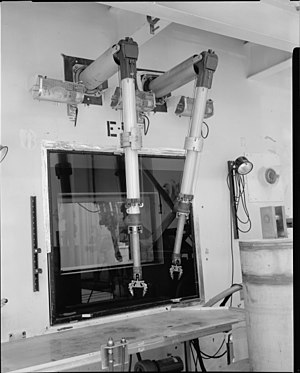Type a search term to find related articles by LIMS subject matter experts gathered from the most trusted and dynamic collaboration tools in the laboratory informatics industry.

A remote manipulator, also known as a telefactor, telemanipulator, or waldo (after the 1942 short story "Waldo" by Robert A. Heinlein which features a man who invents and uses such devices),[1] is a device which, through electronic, hydraulic, or mechanical linkages, allows a hand-like mechanism to be controlled by a human operator. The purpose of such a device is usually to move or manipulate hazardous materials for reasons of safety, similar to the operation and play of a claw crane game.

In 1945, the company Central Research Laboratories[2] was given the contract to develop a remote manipulator for the Argonne National Laboratory. The intent was to replace devices which manipulated highly radioactive materials from above a sealed chamber or hot cell, with a mechanism which operated through the side wall of the chamber, allowing a researcher to stand normally while working.
The result was the Master-Slave Manipulator Mk. 8, or MSM-8, which became the iconic remote manipulator[3] seen in newsreels and movies, such as The Andromeda Strain or THX 1138.
Robert A. Heinlein claimed a much earlier origin for remote manipulators.[4] He wrote that he got the idea for "waldos" after reading a 1918 article in Popular Mechanics about "a poor fellow afflicted with myasthenia gravis ... [who] devised complicated lever arrangements to enable him to use what little strength he had." An article in Science Robotics on robots, science fiction, and nuclear accidents[5] discusses how the science fiction waldos are now a major type of real-world robots used in the nuclear industry.